Post by canadamike on May 25, 2008 22:33:13 GMT -5
Since it is a bit slow, I tought the timing would be perfect for us to start showing pictures from our gardens. I took many, here they are:
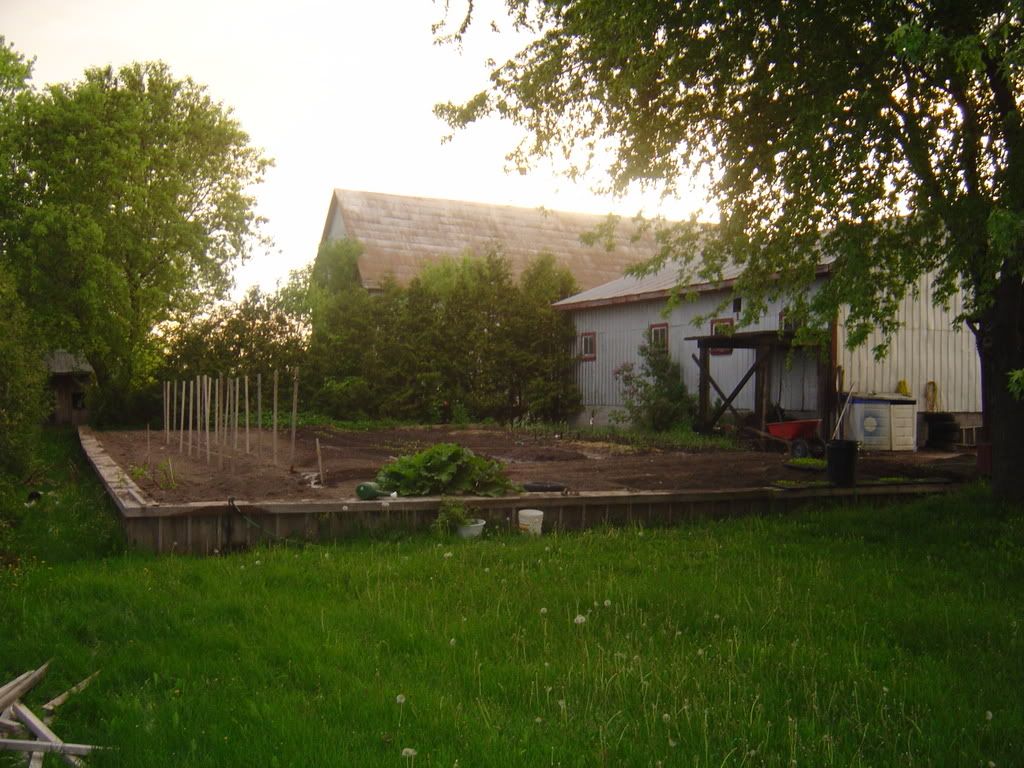
This is a view of the kitchen garden, which does a bit more than that. It all started there. Cedar posts (see left especially) have been planted to level the soil, decorated a bit then covered with a 2 x 12 of cedar to walk on around the garden, sit on it etc... As we have lots of cedar, we will this summer build a solid treillis to provide support for climbing cukes or other cucurbits, while grapevines are growing to eventually take over.
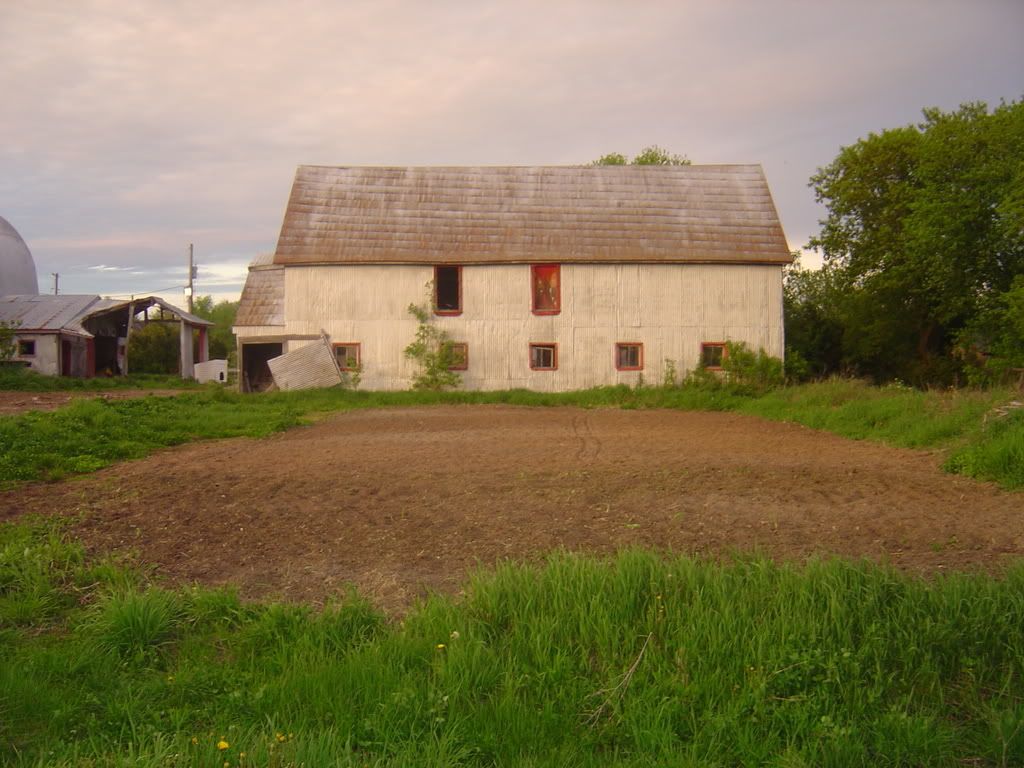
This very old building, used for pigs, chickens, and now junk
was once the parish community hall, there , on the farm.
The nude soil, the only patch of sand we have (trucked in over rocks and clay) is about 50' x 100'. It will soon welcome 4 inches of mushroom compost, then 1000 strawberry plants, including the famous french ''MARA DES BOIS'', said to be one of the best in the world ( we will see about that this fall, as it is everbearing) I will aso plant 500 SPARKLE, and a few ANAIS, another french everbearing that I got from a friend.
French strawberries are generally much more flavourful than american ones, and a lot of them require an alcaline to neural soil, as opposed to our usual north-american acidic soil berries.
But then, it is the french that created the big strawberry we eat, and to them taste is always the most important thing, production comes second. Last week I met a lady at Home Sense, in the fine products section, she was looking for truffle oil like me (9.99$ instead of 35$ ans as good as the european ones, here is a plug ). She was coming back from Dordogne in France where she ate MARA DES BOIS strawberries, and said hey were the best she ever had in her life, something that is kind of a recuring theme when I chat and visit forums across the big pond. The greatest chefs inFrance have joined together as a group behind Mara and they are very actively promoting it. Now you know why I spent the year looking for it.
). She was coming back from Dordogne in France where she ate MARA DES BOIS strawberries, and said hey were the best she ever had in her life, something that is kind of a recuring theme when I chat and visit forums across the big pond. The greatest chefs inFrance have joined together as a group behind Mara and they are very actively promoting it. Now you know why I spent the year looking for it.
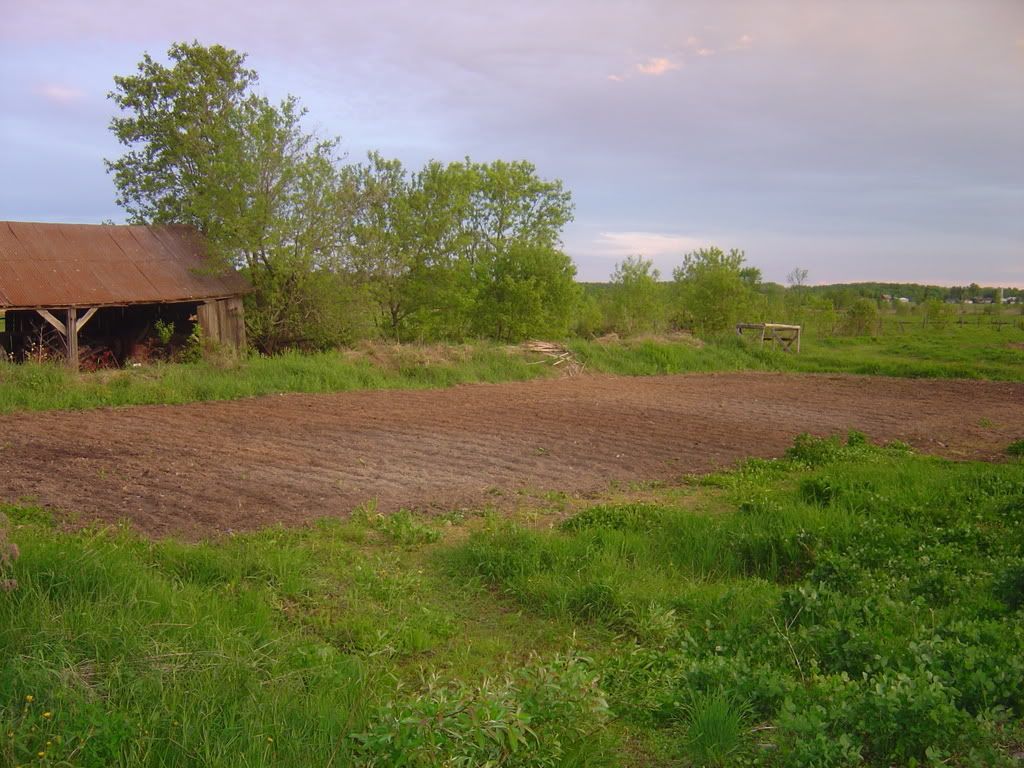
Another view of it.
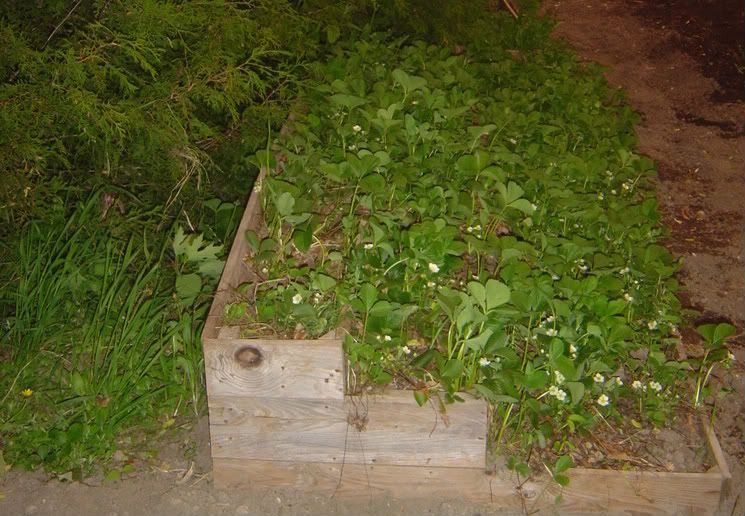
We had a few Tribute stawberries, so I decided to build a staircase container, there is about 100 plants in this 44'' x 96'' staircase. It means a lot of space saving and fantastic production in a very tight space. I can't fix the rotating problem of this image and the next, sorry, they keep coming back like that.
It cannot be filled with real soil but has to be treated like a container, which it really is. I put in a couple of 4 cubic feet of bales
of peat moss, along with a large bag of horticultural perlite and lots of old manure and compost. 3 years later, dandelions are still a charm to pluck out, and only one inch of compost is added yearly.
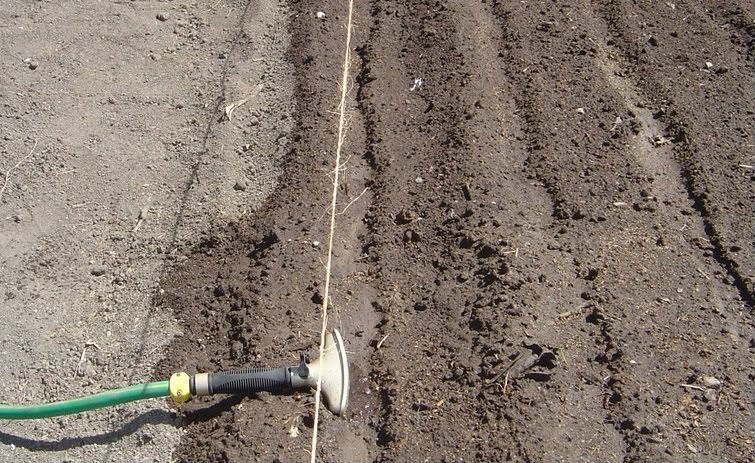
This is how I transplant, I call it hydro planting. The 288 cells trays, or any othes, are abuntantely watered in the shade , then when dried, I set up a twine, and instead of using a metal tool to dig my small trenches, I use that water...( how is it named? )as my trenching/watering combo tool. The water flow is controlable, and is is gentle enough not to dig down to China and draws a trench of the perfect width.
Even at noon in a very hot day, I can transplant and watering is already done, I do not fear to burn my baby leaves and save time by reducing the number of operations.
To me, nothing beats hydro planting.
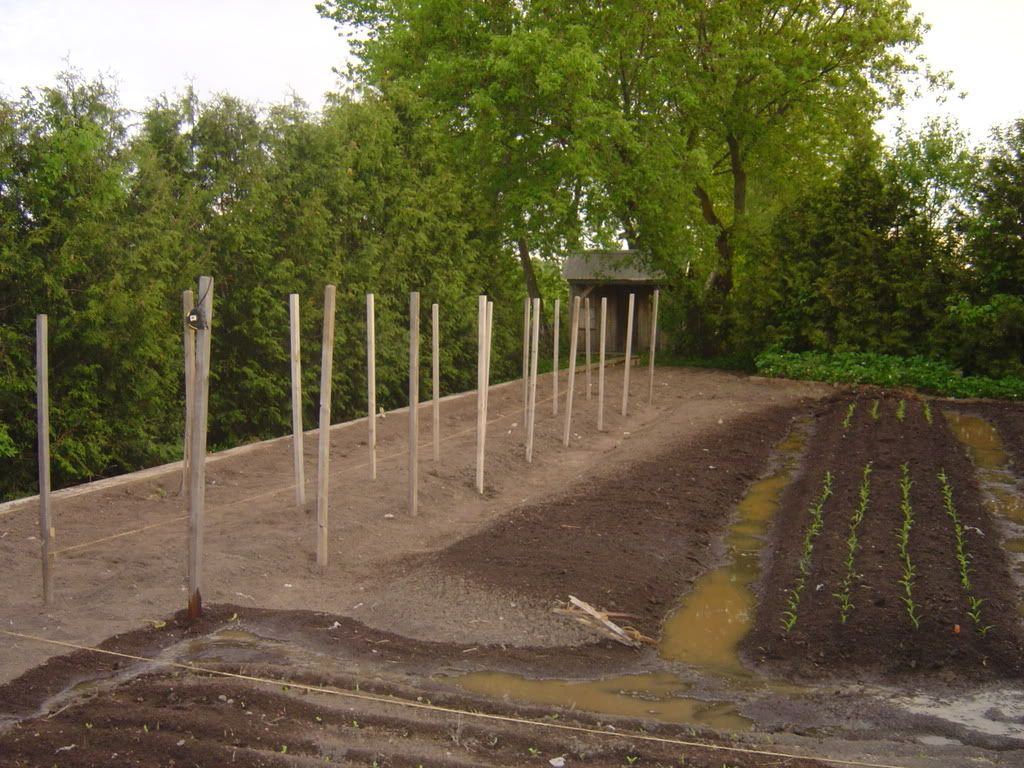
]
Here you see the pre-seeded corn, these ones are Orchard baby and Merlin, and in the middle is some Merlin too, but only seeded after a day in a ziplock and scottowel with seaweed and sonic bloom to hasten emergence. All this corn is interplanted with an italian climbing petit pois ( sweetlet pea ), LAVAGNA. All the corn in that garden is planted at a 6 inch distance. 1 foot between the rows, 4 rows wide, so it can be worked from both sides. The usual 32-36 inches between rows is designed for walking and mechanical weeding, not because the plants need all the space.
Granted we can't hill the corn, but we never do it anyway in this soil, and there is ample wind protection from the cedar edge and the buildings anyway.
The cedar posts at the left are for a potato cage we are bulding. It will be joined by a 5 feet high fence of chicken wire, and filled almost to the top by potatoes , actually four rows, that will the grow through either the sides or the top. One layer of taters will be planted in hole in the ground, 8 inches or so deep, then the fence will be built and fortified, filled with a light mix of soil and lots of mushroom compost ( 55 cubic yards are coming this week, for 600$, the equivalent of 5.5 ten wheelers trucks) and 3 more layers of taters at 16 inches in between them.
If all goes well, it should look like a ''cedar hedge'' of taters by the end of the summer. It is the first time I do it on such a scale, usually I would build round towers of 3-4 feet diameter. It is much fun to see once they grown through the mesh and top.
I will not plant Tom's taters there of course, rather more conventionally, but we also have lots of car and large tractor wheels that will be filled. More photos coming.
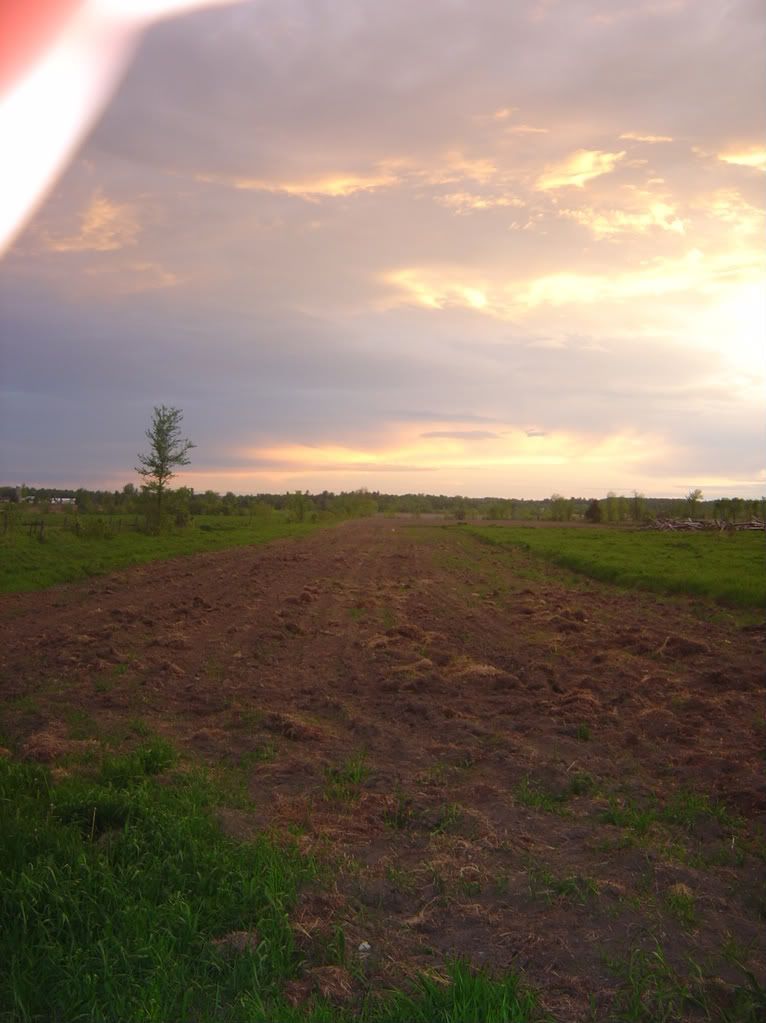
This is where the veggies, melons and the corn will grow when we are finished working it. At this point it is about 50' x 500', but it will be enlarged by roughly 300 feet this week in this patch, and another one of about half an acre will be too.
The soil, clay, unfortunately for our backs, is nevertheless so rich that we can plant the corn every 2 inches and it grows like crazy, along with a jungle of lamb's quarter that gets almost as high as the corn itself. We don't even bother weeding, just come back to harvest. A real no brainer. I figure it is interplanted with a free desirable green manure ;D
The soil is the same in the 45 acres that are rented until the end of the year, where soja has grown for the last 6 years or so. It should be good green manure too...
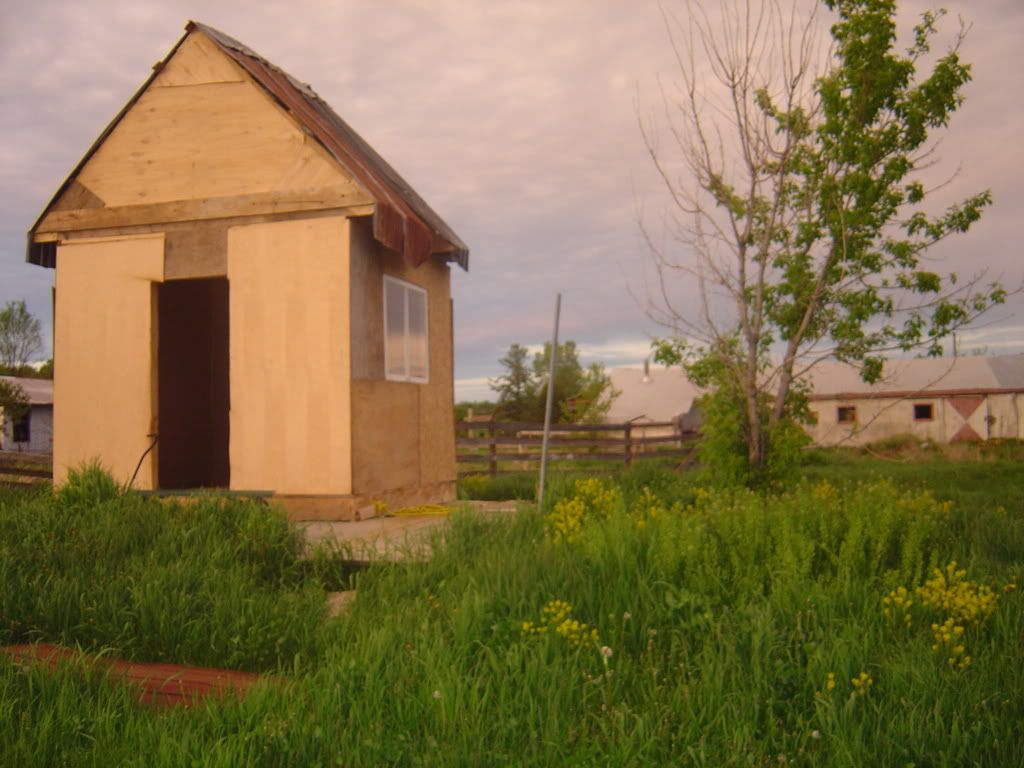
This will be where I snooze in the hot afternoons when my friend's young son finishes it...

My favorite high-tech tool, twine forks I made in the woodshop. It was taken today, and if I look tired it is because I was
Well, that's it for the moment, more to come, and please let us see yours.
Michel

This is a view of the kitchen garden, which does a bit more than that. It all started there. Cedar posts (see left especially) have been planted to level the soil, decorated a bit then covered with a 2 x 12 of cedar to walk on around the garden, sit on it etc... As we have lots of cedar, we will this summer build a solid treillis to provide support for climbing cukes or other cucurbits, while grapevines are growing to eventually take over.

This very old building, used for pigs, chickens, and now junk

was once the parish community hall, there , on the farm.
The nude soil, the only patch of sand we have (trucked in over rocks and clay) is about 50' x 100'. It will soon welcome 4 inches of mushroom compost, then 1000 strawberry plants, including the famous french ''MARA DES BOIS'', said to be one of the best in the world ( we will see about that this fall, as it is everbearing) I will aso plant 500 SPARKLE, and a few ANAIS, another french everbearing that I got from a friend.
French strawberries are generally much more flavourful than american ones, and a lot of them require an alcaline to neural soil, as opposed to our usual north-american acidic soil berries.
But then, it is the french that created the big strawberry we eat, and to them taste is always the most important thing, production comes second. Last week I met a lady at Home Sense, in the fine products section, she was looking for truffle oil like me (9.99$ instead of 35$ ans as good as the european ones, here is a plug
 ). She was coming back from Dordogne in France where she ate MARA DES BOIS strawberries, and said hey were the best she ever had in her life, something that is kind of a recuring theme when I chat and visit forums across the big pond. The greatest chefs inFrance have joined together as a group behind Mara and they are very actively promoting it. Now you know why I spent the year looking for it.
). She was coming back from Dordogne in France where she ate MARA DES BOIS strawberries, and said hey were the best she ever had in her life, something that is kind of a recuring theme when I chat and visit forums across the big pond. The greatest chefs inFrance have joined together as a group behind Mara and they are very actively promoting it. Now you know why I spent the year looking for it.
Another view of it.

We had a few Tribute stawberries, so I decided to build a staircase container, there is about 100 plants in this 44'' x 96'' staircase. It means a lot of space saving and fantastic production in a very tight space. I can't fix the rotating problem of this image and the next, sorry, they keep coming back like that.
It cannot be filled with real soil but has to be treated like a container, which it really is. I put in a couple of 4 cubic feet of bales
of peat moss, along with a large bag of horticultural perlite and lots of old manure and compost. 3 years later, dandelions are still a charm to pluck out, and only one inch of compost is added yearly.

This is how I transplant, I call it hydro planting. The 288 cells trays, or any othes, are abuntantely watered in the shade , then when dried, I set up a twine, and instead of using a metal tool to dig my small trenches, I use that water...( how is it named? )as my trenching/watering combo tool. The water flow is controlable, and is is gentle enough not to dig down to China and draws a trench of the perfect width.
Even at noon in a very hot day, I can transplant and watering is already done, I do not fear to burn my baby leaves and save time by reducing the number of operations.
To me, nothing beats hydro planting.

]
Here you see the pre-seeded corn, these ones are Orchard baby and Merlin, and in the middle is some Merlin too, but only seeded after a day in a ziplock and scottowel with seaweed and sonic bloom to hasten emergence. All this corn is interplanted with an italian climbing petit pois ( sweetlet pea ), LAVAGNA. All the corn in that garden is planted at a 6 inch distance. 1 foot between the rows, 4 rows wide, so it can be worked from both sides. The usual 32-36 inches between rows is designed for walking and mechanical weeding, not because the plants need all the space.
Granted we can't hill the corn, but we never do it anyway in this soil, and there is ample wind protection from the cedar edge and the buildings anyway.
The cedar posts at the left are for a potato cage we are bulding. It will be joined by a 5 feet high fence of chicken wire, and filled almost to the top by potatoes , actually four rows, that will the grow through either the sides or the top. One layer of taters will be planted in hole in the ground, 8 inches or so deep, then the fence will be built and fortified, filled with a light mix of soil and lots of mushroom compost ( 55 cubic yards are coming this week, for 600$, the equivalent of 5.5 ten wheelers trucks) and 3 more layers of taters at 16 inches in between them.
If all goes well, it should look like a ''cedar hedge'' of taters by the end of the summer. It is the first time I do it on such a scale, usually I would build round towers of 3-4 feet diameter. It is much fun to see once they grown through the mesh and top.
I will not plant Tom's taters there of course, rather more conventionally, but we also have lots of car and large tractor wheels that will be filled. More photos coming.

This is where the veggies, melons and the corn will grow when we are finished working it. At this point it is about 50' x 500', but it will be enlarged by roughly 300 feet this week in this patch, and another one of about half an acre will be too.
The soil, clay, unfortunately for our backs, is nevertheless so rich that we can plant the corn every 2 inches and it grows like crazy, along with a jungle of lamb's quarter that gets almost as high as the corn itself. We don't even bother weeding, just come back to harvest. A real no brainer. I figure it is interplanted with a free desirable green manure ;D
The soil is the same in the 45 acres that are rented until the end of the year, where soja has grown for the last 6 years or so. It should be good green manure too...


This will be where I snooze in the hot afternoons when my friend's young son finishes it...

My favorite high-tech tool, twine forks I made in the woodshop. It was taken today, and if I look tired it is because I was

Well, that's it for the moment, more to come, and please let us see yours.
Michel






